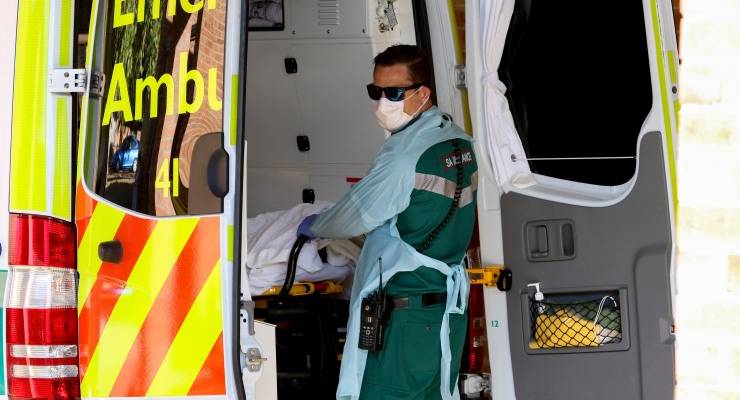
Shock jock Alan Jones again courted controversy this week, saying that Australia is now “facing the health version of global warming. Exaggeration in almost everything. Certainly in description, and certainly in behaviour.”
But the latest statistics from the World Health Organisation show alarm is somewhat necessary when dealing with the global threat of coronavirus. COVID-19 so far has a fatality rate of between 1% and 4% — up to 40 times higher than the 0.1% fatality rate of the flu.
With many of the comparisons between the impacts of coronavirus and influenza taking numbers from the US, let’s look at how the statistics measure in Australia.
Fatality doesn’t compare
In 2018, the flu (or pneumonia, mostly caused by the flu) killed 3102 people in Australia, around 5% of the 58,570 laboratory-confirmed cases from that year. But this fatality rate is grossly over-represented: many people with the flu do not get tested.
Professor Robert Booy, head of clinical research at the National Centre for Immunisation Research and Surveillance told Crikey that during any given winter the flu infects between 5% to 25% of the population. Of those cases, just a fraction are fatal.
“The seasonal death rate on a population basis is one in 1000 to 10,000 worldwide,” he said. That makes a fatality rate of 0.1% to 0.01%.
But COVID-19 is much more severe. “Coronavirus will be at least 10% more deadly than seasonal influenza,” Booy said.
Data from the John Hopkins University coronavirus resource centre records a world-wide fatality rate much higher than that. At time of writing there are 214,894 confirmed cases of coronavirus, with 8732 deaths — an initial fatality rate of just over 4%.
We’ll have to wait for better data to be able to say that with clarity, however — thanks to a shortage of testing kits and limited information at the start of the outbreak, many infected people with mild symptoms wouldn’t have gotten tested. This could mean a lower fatality rate of 1%.
Given Australia doesn’t have enough intensive care beds to manage potentially huge numbers of critically ill people, flattening the curve of infection is incredibly important.
Australia’s horror flu season of 2017, which killed 1,255 people throughout the year does compare to the coronavirus, with a standardised death rate of 3.9 per 100,000 persons.
The difference comes down to who is susceptible.
Demographics don’t compare
In Australia in 2018 those who died from the flu had a median age of 89.3.
“Ninety per cent of those who die from the flu in Australia are over 65, and most are over 75,” Booy said.
The coronavirus, however, is dangerous not just to those over 65, but people over 50, too. A study conducted last month from the Chinese Centre for Disease Control and Prevention found the virus killed 14.8% of people over 80 who contracted the disease, 11.6% of those aged 60 to 79, and 1.3% of those aged 50 to 59.
Patients ages 10 to 19 had the same chance of dying from COVID-19 as patients in their twenties and thirties.
So far, six people have died in Australia from the coronavirus. The youngest was 77 years old.
What does it have in common?
Both coronavirus and influenza are contagious viruses which cause respiratory illness, and present very similarly, Booy said.
“They both present with an upper respiratory infection, especially cough, fever, malaise, tiredness and shortness of breath.”
The difference? One is anywhere between 10 and 40 times more likely to kill you than the flu. Wash your hands, and keep your distance from others.








Alan jones, with typical redneck neckstyle bravado, is preaching Boris Johnsons herd infection policy from behind the safety of self-isolation while doing his radio show at home, he shouldn’t worry after years of exposure to the other viral shocks jocks at 2GB this one shouldn’t worry him, he must be immune by now.
As Alan no doubt kicks back in his splendid country retreat with locked gates, hand sanitizer mountain and bidets.
This is a genuine query. Can we actually draw a conclusion like a death rate of 4%? The article says 4% of “confirmed cases”; but in a world where a) there is a shortage of test kits, so that not everyone who asks for a test gets one, b) there seem to be cases where someone is infected but has no symptoms, so may well not seek a test and c) people with mild symptoms also sometimes don’t get tested, isn’t it possible, even likely, that the fatality rate among actual (including untested) cases is somewhat lower?
Were similar things observed in flu epidemics?
how many are dying of this virus but not diagnosed, in the U.S the Trump administration not only doesn`t know the effects on the homeless but they don’t care, It was once said that Kerry packer stated the true population of the world was 5000, the rest were simply here to do the work and fight the wars, like drones in a beehive and I`m sure that’s the opinion of the conservative classes worldwide.
Another way of comparing the 1918-20 flu pandemic and the 2020 COVID-19 pandemic is to remember we are at the beginning of the COVID-19 pandemic. So we can foresee the implications of this pandemic as inadequately as our forbears did with Spanish Flu in April 1918
How much longer is Nine Media going to enable the fake news spouted by Jones?
DF, Murdoch’s sky, Stokes channel seven and nine and radio 2GB are all part of Murdoch`s self-serving propaganda machine if people boycotted them they would change overnight, they play to the dumb and stupid and the ideologically rusted on redneck base they believe the snake bite only kills others and never them, they are about to find out how wrong and stupid they really are.